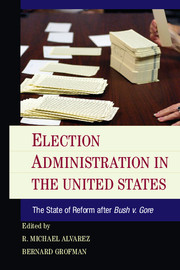Book contents
- Frontmatter
- Contents
- List of Contributors
- Foreword
- Acknowledgments
- Editors’ Introduction
- Part I Bush v. Gore in Perspective
- Part II What Has Changed since Bush v. Gore?
- 4 What Hath HAVA Wrought?
- 5 Voter Confidence in 2010
- 6 Early Voting after Bush v. Gore
- 7 Absentee Ballot Regimes
- Part III Remaining Challenges
- References
- Index
6 - Early Voting after Bush v. Gore
Published online by Cambridge University Press: 05 October 2014
- Frontmatter
- Contents
- List of Contributors
- Foreword
- Acknowledgments
- Editors’ Introduction
- Part I Bush v. Gore in Perspective
- Part II What Has Changed since Bush v. Gore?
- 4 What Hath HAVA Wrought?
- 5 Voter Confidence in 2010
- 6 Early Voting after Bush v. Gore
- 7 Absentee Ballot Regimes
- Part III Remaining Challenges
- References
- Index
Summary
The Supreme Court’s decision in Bush v. Gore was explicitly limited in its judicial scope: it awarded the 2000 election to George W. Bush – and nothing more. But the aftermath was a different matter: in the years following, the “case and controversy from which it arose gave rise to a new wave of legislative and judicial attention to the mechanics of elections” (Lowenstein, Hasen, and Tokaji, 2008, 82). A sea change in media coverage and extensive legal commentary shone a light on every aspect of America’s election system. In this chapter, we concern ourselves with just one of these: early voting.
Early (or “convenience”) voting is a family of related methods by which citizens cast ballots at a time and place other than on election day at the precinct. Expanding outward from its modest beginnings in a small number of reformist Western states (California, Oregon, and Washington) joined by one Midwestern (Iowa) and two Southern (Texas, Tennessee) pioneers, early voting has become a regular fixture of American elections. In the 2008 presidential contest, nearly one-third of votes were cast at a place and time other than the precinct on election day.
- Type
- Chapter
- Information
- Election Administration in the United StatesThe State of Reform after Bush v. Gore, pp. 120 - 143Publisher: Cambridge University PressPrint publication year: 2014



